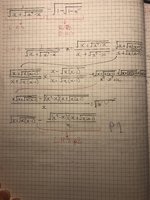Seemingly impossible question
- Thread starter Levido
- Start date
Please see new post. Posted it as soon as I could but needed approval so you didn’t see it. Looks like it’s up now. I believe it’s asking to simplify the expression. ThanksPlease read the guidelines for posting. What you posted makes no sense in that there are no instruction to tell us what is required.
You have not shown any of your own work, nor have you said what you do not understand. Please reply.
\(\displaystyle \dfrac{1}{\sqrt{x+\sqrt{x^2-x}}} - \sqrt{1-\sqrt{1-x^{-1}}} =\\
\dfrac{1-\sqrt{1-\sqrt{1-x^{-1}}}\sqrt{x+\sqrt{x^2-x}}}{\sqrt{x+\sqrt{x^2-x}}} =\\
\dfrac{1 - \sqrt{(1-\sqrt{1-x^{-1}})x(1+\sqrt{1-x^{-1}}})}{\sqrt{x+\sqrt{x^2-x}}}=\\
\dfrac{1-\sqrt{x}\sqrt{1-(1-x^{-1})}}{\sqrt{x}\sqrt{1+\sqrt{1-x^{-1}}}}=\\
\dfrac{1-\sqrt{x}\sqrt{x^{-1}}}{\sqrt{x}\sqrt{1+\sqrt{1-x^{-1}}}} = \\
\dfrac{1-1}{\sqrt{x}\sqrt{1+\sqrt{1-x^{-1}}}}=\\
0
\)
\dfrac{1-\sqrt{1-\sqrt{1-x^{-1}}}\sqrt{x+\sqrt{x^2-x}}}{\sqrt{x+\sqrt{x^2-x}}} =\\
\dfrac{1 - \sqrt{(1-\sqrt{1-x^{-1}})x(1+\sqrt{1-x^{-1}}})}{\sqrt{x+\sqrt{x^2-x}}}=\\
\dfrac{1-\sqrt{x}\sqrt{1-(1-x^{-1})}}{\sqrt{x}\sqrt{1+\sqrt{1-x^{-1}}}}=\\
\dfrac{1-\sqrt{x}\sqrt{x^{-1}}}{\sqrt{x}\sqrt{1+\sqrt{1-x^{-1}}}} = \\
\dfrac{1-1}{\sqrt{x}\sqrt{1+\sqrt{1-x^{-1}}}}=\\
0
\)
Last edited:
OK
First point is that if the task is to simplify an expression, there is no LHS and RHS unless you create an equation.
[MATH]y = \dfrac{1}{\sqrt{x + \sqrt{x^2 - x}}} - \sqrt{1 - \sqrt{1 - x^{-1}}}.[/MATH]
If working with equations feels more natural to you, go ahead and do that, but all you have done is to make the entire expression the RHS of the equation. Talking about LHS and RHS of an expression will lead you astray.
The very first thing I would is to substitute variables to minimize the risk of transcription errors.
[MATH]p= 1 - x^{-1} = 1 - \dfrac{1}{x} = \dfrac{x - 1}{x}, \ q = x^2 - x = x^2 * \left ( 1 - \dfrac{1}{x} \right ) = px^2, \ r = 1 - \sqrt{p}, \text { and }[/MATH]
[MATH]s = x^2 + \sqrt{q} = x^2 + x\sqrt{p}.[/MATH]
[MATH]\therefore y = \dfrac{1}{\sqrt{s}} - \sqrt{r} = \dfrac{1 - (\sqrt{s} * \sqrt{r})}{\sqrt{s}} = \dfrac{\sqrt{s} - s\sqrt{r}}{s}.[/MATH]
First point is that if the task is to simplify an expression, there is no LHS and RHS unless you create an equation.
[MATH]y = \dfrac{1}{\sqrt{x + \sqrt{x^2 - x}}} - \sqrt{1 - \sqrt{1 - x^{-1}}}.[/MATH]
If working with equations feels more natural to you, go ahead and do that, but all you have done is to make the entire expression the RHS of the equation. Talking about LHS and RHS of an expression will lead you astray.
The very first thing I would is to substitute variables to minimize the risk of transcription errors.
[MATH]p= 1 - x^{-1} = 1 - \dfrac{1}{x} = \dfrac{x - 1}{x}, \ q = x^2 - x = x^2 * \left ( 1 - \dfrac{1}{x} \right ) = px^2, \ r = 1 - \sqrt{p}, \text { and }[/MATH]
[MATH]s = x^2 + \sqrt{q} = x^2 + x\sqrt{p}.[/MATH]
[MATH]\therefore y = \dfrac{1}{\sqrt{s}} - \sqrt{r} = \dfrac{1 - (\sqrt{s} * \sqrt{r})}{\sqrt{s}} = \dfrac{\sqrt{s} - s\sqrt{r}}{s}.[/MATH]
Last edited:
Hi JeffM. Sorry if my working confused you. When I used left and right hand side I meant of the expression, which was supposed to allow me to simplify each side separately. I recognize now that it is the same abbreviations used in equations.OK
First point is that if the task is to simplify an expression, there is no LHS and RHS unless you create an equation.
I think the question was a bit misleading when it said to evaluate and only gave a strict inequality. I read online that evaluate is talking about questions where you have to substitute values for algebraic variables (think x+2, x=1). Correct me if I’m wrong but I think clearer terminology could have been used
Thanks for your response. I still need to work through it, but Romsek did a wonderful job getting to 0, thank you both so much.
Dr.Peterson
Elite Member
- Joined
- Nov 12, 2017
- Messages
- 16,811
I think the question was a bit misleading when it said to evaluate and only gave a strict inequality. I read online that evaluate is talking about questions where you have to substitute values for algebraic variables (think x+2, x=1). Correct me if I’m wrong but I think clearer terminology could have been used
Thanks for your response. I still need to work through it, but Romsek did a wonderful job getting to 0, thank you both so much.
"Evaluate" means "find the value of"; it does not always imply substituting a value of a variable, but does tend to imply that the result will be a single number.
In this case, it suggests that the answer will be a constant, not a variable expression; it's not obvious that that would happen, so I would interpret it as meaning "simplify as far as possible, and expect that the result will be very simple". I would have written the problem as "simplify" if I were writing it and didn't want to give that hint.
As for the inequality x>1, that is just to ensure that the expression can be evaluated. It happens to be valid also if x=1, but that doesn't matter.
JeffM's method is good in general, but here it might hide important relationships that would simplify things earlier. Romsek's approach focusing on combining the two fractions immediately is probably what I would have done, in hope of bringing all parts into contact with one another and letting interesting things happen. The insights used at various steps are worth learning!



